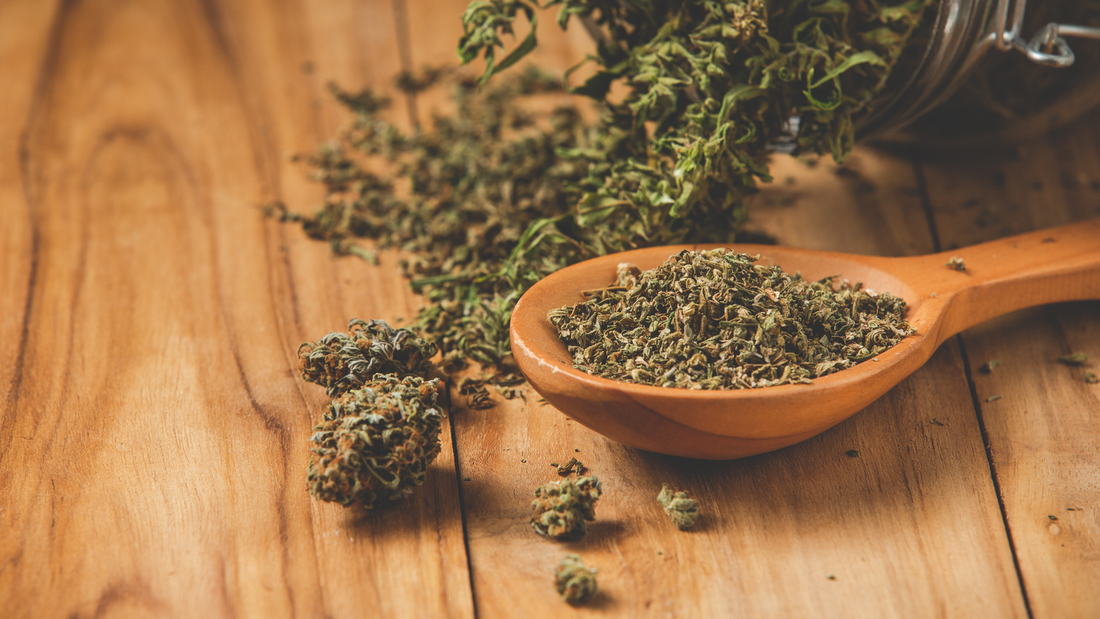
CBD Biomass: Everything You Need to Know
Share
As interest in CBD products continues to soar, understanding the foundational elements behind these products, CBD biomass, has become increasingly important. But what exactly is CBD biomass, and why is it garnering so much attention?
In this article, we'll unravel everything you need to know about CBD biomass. From its composition and production process to its various uses and benefits, we’ve got all the essential details covered.
Whether you’re a seasoned CBD enthusiast or new to the scene, this comprehensive guide will provide valuable insights into the backbone of the CBD market. However, before diving into the details, let’s take a look at what this product is in the first place.
What is CBD Biomass?
In essence, CBD biomass refers to the bulk material derived from the hemp plant that is used to extract purified CBD products. It doesn’t contain just the flower; it also includes the leaves and stalks, which also contain varying levels of cannabidiol and other beneficial compounds.
Unlike pure CBD oils or isolates, which are refined and processed to achieve high concentrations of CBD, biomass is the raw material that kickstarts the extraction process. Think of it as the foundation from which various CBD products are built.
Furthermore, the quality of the biomass significantly influences the quality of the final CBD product, making it a highly valued resource in the CBD industry, particularly for producing oils, tinctures, and other extracts.
However, to fully understand what CBD biomass is, it’s crucial to delve into how it’s made. So let’s take a look at the production process.

The Production Process of CBD Biomass
The journey of CBD biomass from seed to harvest is a meticulous process that requires careful attention to detail at every stage. So let’s take a closer look at how CBD biomass is produced, highlighting the crucial factors that influence its quality.
The Cultivation Stage
The production of high-quality CBD biomass begins with selecting the right hemp strains, which are chosen for their rich CBD content. Once the strains are selected, farmers must also consider factors such as soil quality, climate, and planting density to create the optimal growing conditions.
Furthermore, they must also select their organic farming methods that are used to avoid harmful pesticides and chemicals, ensuring a purer end product. Once the strains, growth conditions, and farming practices are selected, the seeds are planted.

The Growing Stage
Once the seeds have been planted, the growing stage begins, where it’s essential that the plants have the optimal conditions to produce high-quality CBD. In order to achieve this, there are a few factors that farmers consider, including:
- The drainage of the soil, which must drain easily to prevent mold or fungus buildup,
- The pH of the soil, which must be between 6 and 7.5 to ensure that the plant grows accordingly,
- The amount of sunlight that needs to be consistent and indirect in most cases,
- And the amount of water they receive, which depends on the strain the farmers are growing.
Though hemp is relatively resilient and can adapt to various climates, farmers must also monitor and manage pests, weeds, and diseases diligently to protect the plants throughout the growing season.
This part of the process typically lasts a few weeks. Once the strain is grown and the trichomes on the flower have taken on a milky-white color, indicating that the strain has a high CBD count, the biomass is ready to be harvested.

The Harvesting Stage
Timing is everything when it comes to harvesting hemp for CBD biomass, and the typical ideal harvesting time is usually around 90 to 120 days after planting the seed. Once the seeds are ready for harvest, farmers use specialized machinery to cut the plants and leave them to dry out, preparing them for the processing stage.
The Processing Stage
Once the hemp plants are dried, they go through curing to preserve their cannabinoid profile and prevent mold or degradation. The cured flowers are then milled or ground into a coarse powder, which is the product that will be used for extraction.
Every step in the production process, from cultivation to initial processing, plays a critical role in determining the quality of the CBD biomass. For instance, proper growing and harvesting ensure that the biomass contains high levels of CBD, while drying and curing help maintain the integrity of these compounds, resulting in a superior raw material for CBD extraction.
So, now that we understand what CBD biomass is and how it’s produced, let’s explore some of its uses to fully understand the far reaches of this product in the cannabis and wellness industries.

What is CBD Biomass Used For?
CBD biomass is a versatile raw material with a range of applications in the world of cannabis products. So let’s break down its primary uses and how it contributes to the diverse array of CBD products on the market.
CBD Oil Extractions
The most common use of CBD biomass is the extraction of CBD oil, which is achieved by extracting cannabinoids, terpenes, and other beneficial compounds from the biomass using various methods such as CO2 extraction or ethanol extraction.
The oil then serves as the foundation for a wide range of CBD products, including tinctures, capsules, topicals, gummies, and even soaps. So, without CBD biomass, a lot of the products we know and love wouldn’t exist.
CBD Isolate and Distillate Production
CBD biomass is also used to create more refined products like CBD isolates and distillates, which are purified forms of CBD, typically produced by further processing oil extracts to remove all other cannabinoids, terpenes, and plant material from the end product.
Both products are then used in various consumer goods for their potent and precise effects, making them highly regarded in the medicinal cannabis industry and a popular product for those who don’t want the psycoactive effects linked to other cannabinoids.

CBD-Infused Product Creation
Beyond extraction, this raw material can be used as-is to create CBD-infused products ranging from edibles and beverages to skincare products like lotions and balms. And since these products are made with the compounds present in the biomass, they offer a range of therapeutic effects and enhanced consumer experiences.
Industrial Research
In addition to consumer products, CBD biomass also has applications in the research field, given that it can be used to develop new CBD-based formulations or to study the plant's cannabinoid profile and potential benefits in greater detail.
Its role in extracting and refining CBD, along with its use in creating diverse consumer goods, highlights its importance in the cannabis industry. But how can these products be consumed? Let’s take a closer look.

How is CBD Biomass Consumed?
CBD biomass can be consumed in various ways, each offering distinct benefits and experiences. So let’s take a look at the best ways you can use this product to help you determine your path of exploration.
| Method | Use | Benefits |
| Smoking | This involves burning the raw material in joints, bongs, or pipes and inhaling the smoke. | It provides immediate effects, as cannabinoids are rapidly absorbed into the bloodstream. |
| Vaping | It involves heating the CBD biomass or its extracts to produce a vapor that can be inhaled. | It is generally considered less harsh than smoking, as it avoids the combustion process. |
| Tinctures | They are taken sublingually (under the tongue), allowing for quick absorption into the bloodstream. | It offers precise dosing, making it a more controlled experience compared to smoking or vaping. |
| Edibles | These can be found in the form of gummies, chocolates, and snacks which are digested in the stomach. | They offer a discrete and longer-lasting way to incorporate CBD into your routine. |
| Topicals | CBD topicals, including creams, balms, and lotions, are applied directly to the skin. | They are used for targeted relief and can help with localized pain or inflammation. |
| Capsules | They are ingested and undergo digestion and absorption in the gastrointestinal tract. | They offer consistent dosing, making them ideal for those who prefer a straightforward approach. |
| Beverages | They are also digested in the stomach, providing long lasting effects. | They combine the benefits of hydration with the effects of CBD, providing a refreshing experience. |
Each method of consuming CBD biomass offers unique benefits and experiences. Whether you prefer the immediate effects of smoking and vaping or the enjoyment of edibles and beverages, there's a method to suit every preference and need.
However, like with any other cannabis product, there are some benefits and risks you need to consider before trying this substance, so let’s take a look.

The Pros and Cons of CBD Biomass
CBD biomass plays a crucial role in the production of various CBD products, offering a wide range of benefits. However, there are some risks to this product that you may also want to consider. So let’s explore the main pros and cons that come with this product.
| Pros | Cons |
| It’s more affordable than refined products like isolates or high-purity oils. | The quality can vary significantly, leading to inconsistent effectiveness. |
| It has a high yield of cannabinoids, as it encompasses various parts of the hemp plant, resulting in substantial CBD contents. | It needs careful processing to maintain the integrity of the cannabinoids and avoid degrading the final product’s quality. |
| It supports eco-friendly farming as hemp grows quickly and requires fewer resources. | It can contain contaminants like pesticides, heavy metals, or mold. |
| It can be used in a wide range of products, providing flexibility in product development. | It contains lower concentrations of CBD compared to more refined products. |
By carefully considering these factors, both consumers and producers can better navigate the benefits and limitations of CBD biomass in the evolving CBD industry. And if the benefits outweigh the risks for you, let’s get into how to find high-quality CBD biomass.

How to Find High-Quality CBD Biomass
Finding high-quality CBD biomass is essential for ensuring that the final CBD products are potent, safe, and effective. So, here’s a simple guide to help you identify and source the best CBD biomass:
- Look for detailed lab reports that specify the cannabinoid content of the products, which will help you assess whether the biomass meets your desired potency.
- Verify that it has been tested for contaminants by a reputable third-party lab, which will provide information on the presence of any harmful substances.
- Look for suppliers with a track record of providing consistent and reliable products by reading online reviews from previous clients.
- Avoid biomass that looks brown, dry, or has a musty odor, as these can be signs of poor quality or improper handling.
- Check if the CBD biomass supplier holds relevant certifications like Good Manufacturing Practices (GMP), which indicate adherence to high standards.
By researching suppliers, understanding lab reports, and assessing the appearance and smell of the biomass, you can make informed choices and ensure the quality of your CBD products.

Conclusion
CBD biomass offers notable advantages like cost-effectiveness and sustainability, but it also comes with challenges such as variability in quality and the need for proper processing. So to ensure high-quality outcomes, focus on the cannabinoid content, contaminant levels, and proper handling when selecting your product.
By researching reputable suppliers, interpreting lab reports, and evaluating physical characteristics, you can confidently navigate the CBD biomass landscape, whether for personal use or production.
With this knowledge, you can make informed decisions and enjoy a premium CBD experience. So, what are you waiting for? Get your CBD biomass today and save a pretty penny on your wellness experience.
